Suzee Carnel was just 18 when she first heard about The Starship. Bobby Sherman, the pop singer and husband of her older sister Patti, mentioned that he had bought a Boeing 720 plane along with his manager Ward Sylvester with a plan to convert it into a flying tour bus for the most famous musicians in the world.
“Bobby would come home and tell us about this plane. And I’m just going ‘I just got to work on that plane. Come on, Bobby’. My sister Patti [and I], we just wore him down,” Carnel recalls in an interview with LedZepNews.
Unsurprisingly, her family was unhappy with the idea of blonde, 18-year-old Carnel spending hours on a plane filled with rockstars as her first job.
“They thought it would be very bad for me. I’d be around all these crazy people and I would become a groupie and be having sex and drugs and rock and roll. They were not wrong! They were absolutely right. But I had to have my own experience,” Carnel says with a laugh.
For the next four years, Carnel flew across the US with Led Zeppelin, Bob Dylan, The Rolling Stones, Elton John and more of the biggest musical artists of the time.
Carnel spoke to LedZepNews from Malibu, California where she now spends her time as a horse trainer specialising in dressage. Despite much of her time on The Starship happening more than 50 years ago, she clearly recalls some of the characters she spent many hours alongside.
LedZepNews spoke to Carnel following the publication of our exhaustive history of the plane, along with our release of Federal Aviation Administration documents about the aircraft’s history, the publication of the plane’s original 1973 brochure, an account by the plane’s interior designer David E. Bell, an account of the plane’s final flight and our investigation into the country that hired the plane in February 1979.
Before she stepped foot on the plane in 1973, Carnel and her sister had to lobby Sherman into setting up a meeting for her with his manager, Sylvester.
Sylvester, a former manager of The Monkees, had spent $720,000 with Sherman on the 1959 Boeing 720 plane which United Airlines had operated for more than a decade as a passenger plane. The plane was refitted to be suitable for rockstars and Carnel worked for Sylvester as one of the few permanent stewardesses on board.
“I had never worked before as I had just graduated from high school,” Carnel says. “Thankfully I was prepared to be a stewardess by United Airlines. We only had to learn the [Boeing] 720 as that was the only plane I was to be working on.”
Learning the plane was straightforward enough, but Carnel also had to figure out how to handle rockstars. “How could you ever prepare for something like that? It’s one thing to be prepared to be a stewardess. Nobody ever prepared us how to deal with all these personalities,” she says.
“A lot of them, which at the time I didn’t realise, were doing drugs and had some mental illnesses. How do you deal with those kinds of personalities? There was no school for that.”
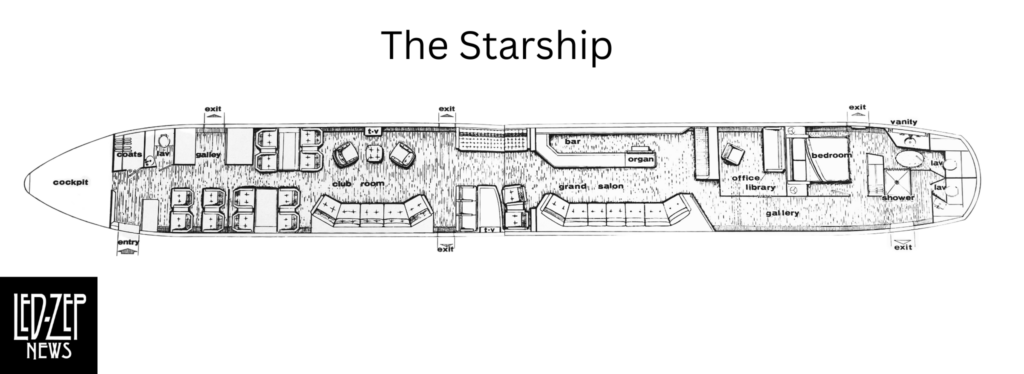
The first client to board the newly renamed Starship, as Sylvester titled the refitted plane, was Led Zeppelin as the band toured the US in 1973.
“Robert Plant was super sweet and fun,” Carnel recalls. “On the plane he was always surrounded by lots [of] his women friends so it was hard to get to know him.”

“John Paul Jones was friendly and ever so polite but usually kept to himself,” she adds. “Jimmy Page was introverted and hard to get to know and hard to understand, especially when he was drinking, but he was always very sweet.”
Carnel can be seen in a video showing the members of Led Zeppelin boarding the plane in 1973, wearing a pink shirt and greeting the band as they returned to the plane.
Peter Grant, the band’s manager, had a reputation in the music industry as both a literal and metaphorical heavyweight. “He dressed kind of interestingly,” Carnel says. “His clothes were really kind of cool for somebody that large.”
Carnel wasn’t the target of Grant’s legendary fury. “I really liked Peter. I got along with him so well,” she says. “He was very interesting and always so nice to me. [He] couldn’t have been nicer. He was really a nice guy, but I could see how they were tough, those guys. They could be intimidating.”
On the 1973 tour, John Bonham was “really sweet. He did do drugs and we hung out together a couple of times and he was high, really high. But he was fine, he was really nice,” Carnel says.

Carnel was fast becoming a fixture of the plane, speaking to journalists as well as the musicians on board. Record Week reported in its September 8, 1973 issue that Carnel had “survived Led Zeppelin” on the plane and was “surely one of its most delightful passengers”. “Her fondest wish is for the Moody Blues to lease the jet next,” it added.
The Moody Blues indeed rented the plane beginning in October 1973. Carnel learned from the band members, particularly on how important playing in the US was for them.
“What I found interesting, especially from Graeme Edge, the drummer in The Moody Blues, was how big, how important America was [to them],” Carnel says. “Being from a small country like England, playing in America was the most incredible experience for them.”
“It just made me realise, ‘wow, I never thought about that, that it would be that big of a deal to play Madison Square Garden or any big facility in America,’” she adds.
These visiting British bands gave the 18-year-old Carnel quite the education. “They taught me a lot about different foods and teas and rituals of food and different drugs. I learned a lot about their drugs and alcohol, the important things in those days,” she says with a laugh.

The list of names Carnel met through working on The Starship is extensive, and she fondly recalls some of the clients. Loggins and Messina “were such good fun, we had the best time with them,” she says. In fact, she got along with them so well that she continued working for them as a stewardess after they switched from the Starship to a tour bus because of the high costs involved.
Elton John was the plane’s second customer, renting it in August 1973 following the end of Led Zeppelin’s US tour. He was also the plane’s most frequent customer, renting it a total of four times. His busy tour schedule meant that celebrity guests were often brought on board.
On September 25, 1973, Stevie Wonder was brought on board without John’s knowledge for a flight from New York to Boston. John was simply told his managers had hired a pianist for the flight, not realising it was his friend. Carnel can be seen leaning on the plane’s bar between John and Wonder in a photograph taken on the plane by Bob Gruen shortly after the surprise guest was revealed.
“Elton was in a really bad mood that day,” Carnel says. “They were trying to let him know that somebody was going to play the organ and he just [said] ‘I don’t want to know. I don’t want anything to do with it.’ I guess they had to tell him it was Stevie Wonder, because he wouldn’t come out of wherever he was.”
An even more high profile guest joined John for a flight on the Starship in November 1974 when John Lennon joined the band for a flight from New York to Boston.
“He came up and asked me about the bands that took the plane and where I lived,” Carnel says. “He was asking me many questions about myself. He was so lovely. It was a very special moment for me.”
Bob Dylan’s 1974 US tour was a stark contrast to John’s star-studded affairs. Beginning on January 3, 1974, Dylan rented the plane but kept the guest list limited to the members of The Band, David Geffen and a couple of other passengers.
“The first trip, the tour manager came up to me and said ‘You are not allowed to talk to Mr Dylan unless he speaks to you first,’” Carnel recalls.
Despite the rocky start, Carnel enjoyed that tour in part because of the presence of the members of The Band. “I had such a good time with Robbie Robertson and The Band. I love Robbie Robertson’s music. It was a wonderful trip for me, I enjoyed myself,” she says.
Perhaps the most legendary tour on The Starship was Led Zeppelin’s three-month 1975 US tour that began in January 1975.
Two years after she first met the band, it was clear that Led Zeppelin had changed, Carnel explains. Bonham was now “as big as a house,” she says, “he had put on a massive amount of weight and his drinking escalated. He was consuming large amounts of alcohol and downers. I think in those days he was taking mandrax and drinking as well. God knows what else. He was getting very wasted.”
Carnel was on the plane in January 1975 on a flight from Chicago to Los Angeles when Bonham went on a now-infamous rampage, an incident frequently recalled in accounts of the band’s backstage excesses.
“He went to the back of the plane and went to sleep in the bedroom and he woke up, he was naked and he had just a bathrobe on,” Carnel recalls. “He’s so fat, it kept falling open. It was a lovely sight!”
“He came out like a bear out of hibernation. He was raving mad. He said some things to me that I’m not going to go into. He meant to grab my chin. Instead, he socked me in the jaw and sent me flying backwards.”
“Peter Grant was standing there and he’s going, ‘just go along with him. Just make him happy. Be nice. Make him happy.’”
“Then [Bonham] rips up to the front of the airplane and grabs one of the stewardesses’ dinner. She had a plate of food and he grabbed that out of her hands and the food went flying over the place because he was still so out of it,” Carnel recalls. “She was just scared to death.”
Bonham’s mid-air rampage didn’t end there. “He tried to break some of the video cassettes … he was just a raving maniac,” Carnel says. “And then he had to go pee. He tried to open up the door in flight. Luckily, he couldn’t. That was so scary. I don’t know how they got him to settle down. He was like the raging bull. He was just a madman through the airplane. It was so much worse than I can ever paint for you. It was just insanity to see somebody go through this.”
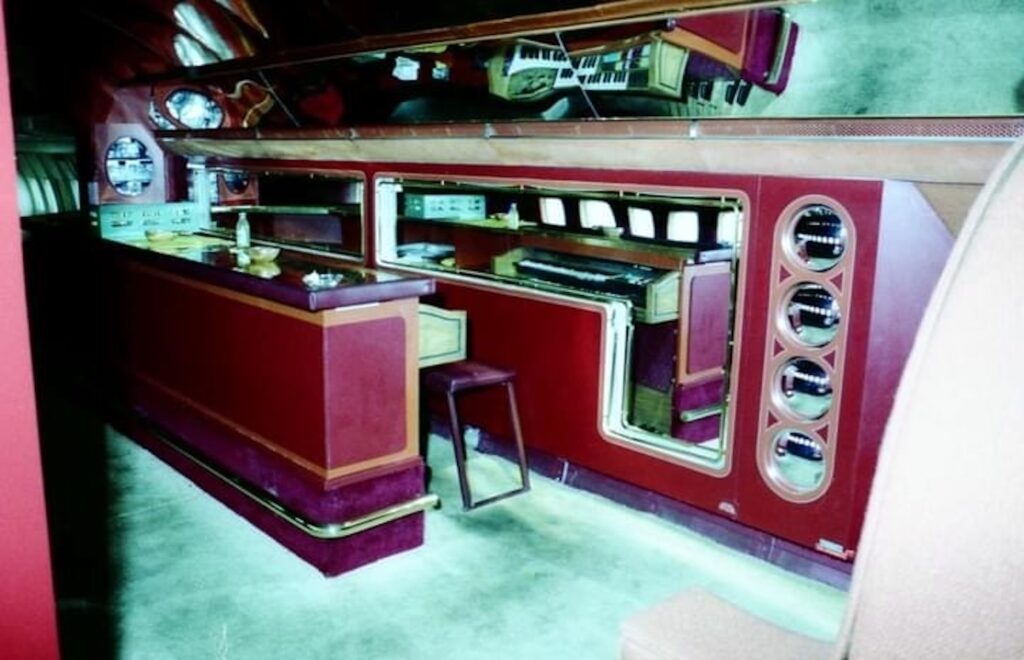
The plane’s crew was given a chance to relax when John Denver rented The Starship from April to May 1975. “They were very nice people, they treated us so well,” Carnel says.
However, it was then time for another marauding rock band to take to the skies when The Rolling Stones rented the plane for the band’s US tour lasting from June to August 1975.
The Rolling Stones were “better behaved” than Led Zeppelin, Carnel says, but she wasn’t a fan of Mick Jagger’s personality. “He and I just didn’t get along. I just didn’t like him and he didn’t like me,” she says. “It started from the first couple of flights. I knew a little judo and he was a black belt in karate so we were sparring around and he flipped me and it hurt. I got hurt.”
“And then I just saw what an asshole he was to his fans. I had to be around him a lot. I didn’t respect him at all,” she adds.
She was no fan of Jagger, but Carnel says Keith Richards and Ronnie Wood were “just fantastic”.
“I had so much fun with them and they were just lovely, lovely human beings,” she says. “They introduced me to reggae music, Bob Marley and the Wailers and The Meters and all these different reggae bands and Muscle Shoals.”
“I got to experience a lot of different types of music with them and Muddy Waters and a lot of blues artists that I never would have come in contact with [otherwise]. Keith and Ronnie were fabulous,” she adds. “I love them.”
Drummer Charlie Watts “was very quiet,” she recalls. “He just kept to himself. I didn’t really have much of a relationship with him.”
Spending hours in the air catering to rockstars meant Carnel developed close bonds with the other people employed to run The Starship. Pilot Hal “Mac” McNicol was “such a sweetheart, a very kind person and an excellent captain,” Carnel says. “I felt safe when he was captain. He was a down to earth man despite being a pilot. He treated me like I was his daughter, very protective.”
Another pilot of the plane was Tony Martineau. “He used to work for a big airline but was fired for rolling a plane on a deadhead flight,” Carnel claims.
The pilots’ professionalism leads Carnel to doubt the allegation made by Joe Jammer in Bob Spitz’s 2021 book “Led Zeppelin: The Biography” that one of the pilots was given a line of cocaine on January 24, 1975 to convince him to fly in a blizzard from Cleveland to Chicago.
The story “is just not believable,” Carnel says. “These guys were so straight … I find that hard to believe, knowing those guys.”
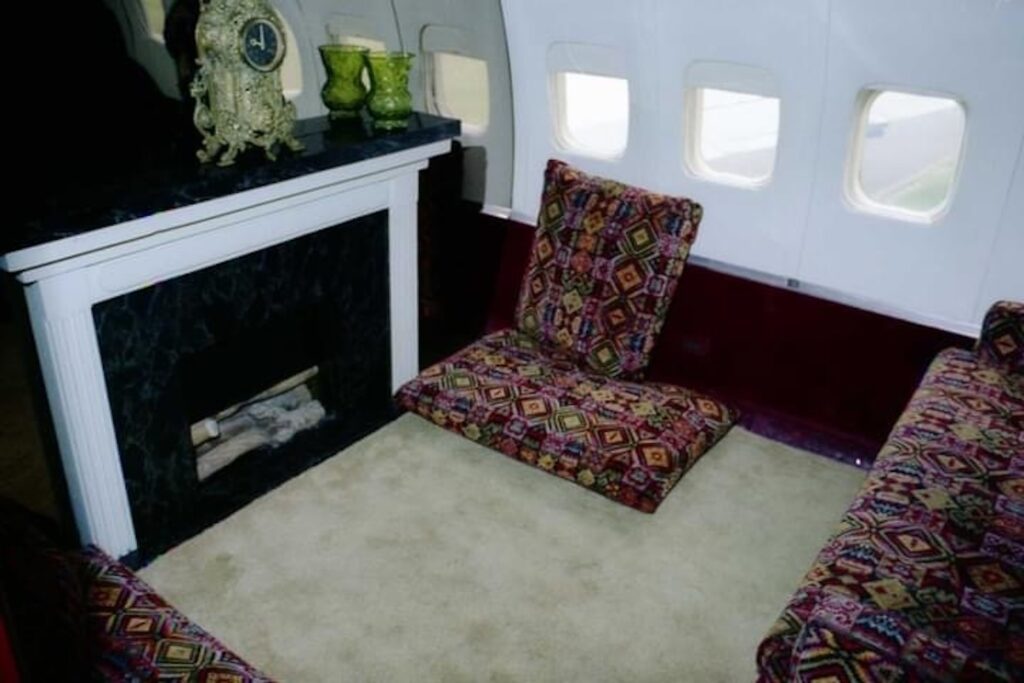
Carnel’s closest companion in the skies was fellow stewardess Bianca Donovan. Donovan was eight years older than Carnel with dark hair and more experience in the entertainment industry thanks to her relationship with Jerry Weintraub.
Weintraub “introduced us and said you two will be friends. He was right,” Carnel says. They eventually shared a house near the beach, spending hours in the air together as well after Carnel recommended her for a stewardess job on The Starship.
The Starship’s final year of operation as a flying tour bus for musicians was 1976. The year began with Olivia Newton-John as a client. She may not have been a rockstar, but her tour was still enjoyable.
“That was a pretty wild trip,” Carnel says. “She was so sweet, oh my God, [they were] the nicest people. Paul Williams was the opening act and Olivia was the headliner.”
“It was a really nice tour, and we had a food fight on that airplane,” Carnel recalls. “We got in so much trouble and it was all the band members and the people that worked with Olivia. We all got into a food fight and ruined the carpet, they had to replace the entire carpet.”
The final musician to use The Starship was Peter Frampton who was also the first artist to take the plane to Europe. For Carnel, it was an eye-opening trip.
“We had 10 days off in London, so that was heaven for me because I had so many friends in London,” she says. “We got to go to all the shows and hang out with them in between [shows], the off days. We were treated like queens, we were really part of the tour. It was so much fun, I had a blast with those people.”
Following Frampton’s world-spanning 1976 tour, The Starship spent two years parked at airports in the US, still painted with “Frampton Comes Alive” and its colourful stars and stripes design.
“Disco started coming into fashion. Those big stadium-type bands, they weren’t selling like they used to. Music was changing, and along with the price of oil, jet fuel, the combination of both of those ended it,” Carnel says.
McCulloch International Airlines took over the business, leading to Carnel working as a stewardess on a BAC One-Eleven for artists such as The Beach Boys and Neil Diamond. She also recalls flying to Spain with Frank Sinatra on Caesar’s Chariot, a likely source of incorrect claims that Sinatra used The Starship before it was grounded.
“Eventually, I was kind of happy to not be living out of a suitcase after all those years, so I was very ready for it to end,” Carnel says. She remained in the music industry, however, working in the A&R department of Chrysalis Records in Los Angeles followed by a period at concert promoter Avalon Attractions.
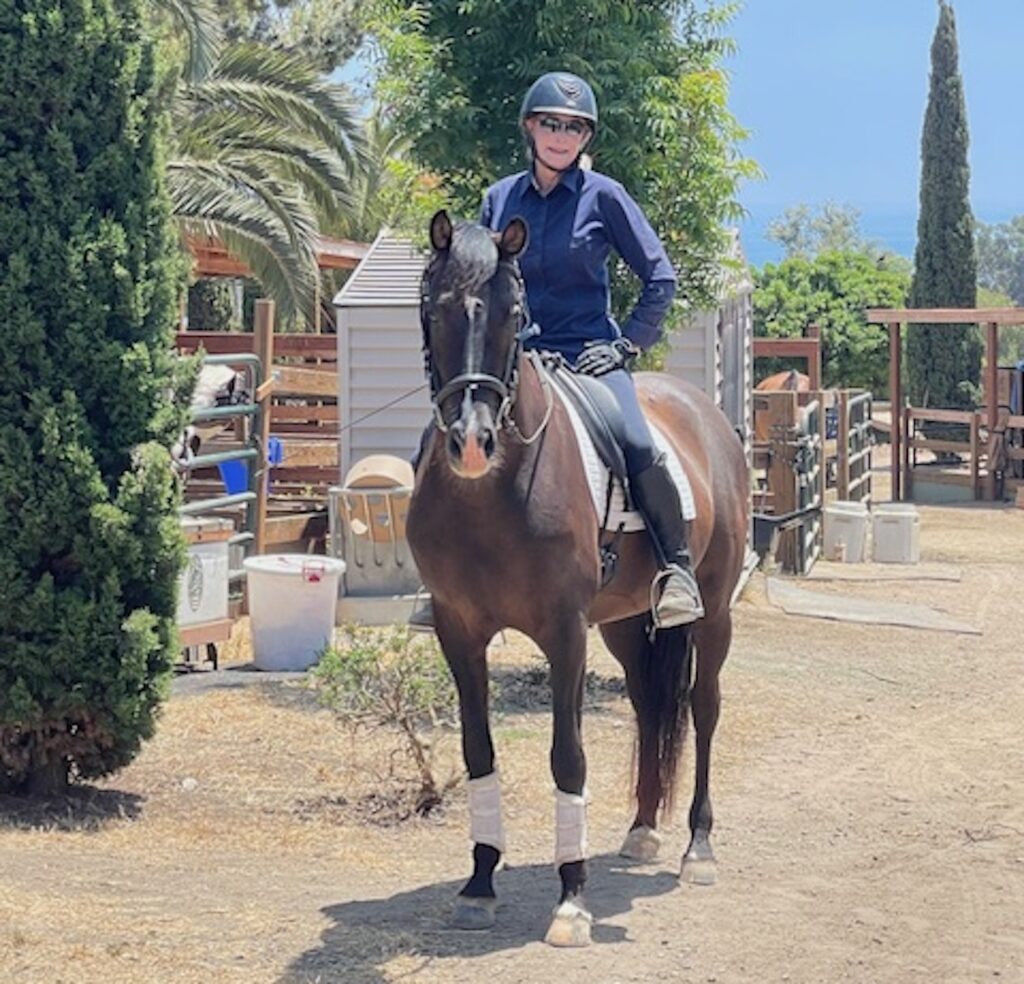
After leaving the entertainment industry, Carnel became a jewellery designer for around a decade. Later in life, Carnel began writing a book about her experiences on The Starship which led her to reconnect with Led Zeppelin’s tour manager Richard Cole.
While on the road with Led Zeppelin in 1973 and 1975, “I didn’t really like him because he was so edgy and had to look after the band and he was just a scuzzy guy on the tour,” Carnel says, “he was not somebody I bonded with.”
But Cole was “like a different person when he was sober. He was wonderful,” Carnel says. “We kept in touch a lot throughout the years on Facebook, mostly, and through other people.”
Carnel spent four years in the skies above America with some of the world’s most famous people, but she now rarely mentions this period of her life. “I used to talk about it all the time, it was a big part of who I was,” she says. “Now it’s just so far removed from me, I rarely talk about it.”
“Maybe after I meet somebody and I know them for a few months, it’ll come up: ‘When I was on tour with this person…’ But a lot of people would have no clue,” she adds.
Today, Carnel’s passion is the decidedly more down to earth pastime of horse training, a world removed from spending hours in the skies with rockstars.
When LedZepNews mentions that a collection of books of matches from The Starship was advertised for sale with an estimate up to $4,000, Carnel mentions previously owning many of the same items. “God, I could have bought a horse,” she exclaims excitedly.
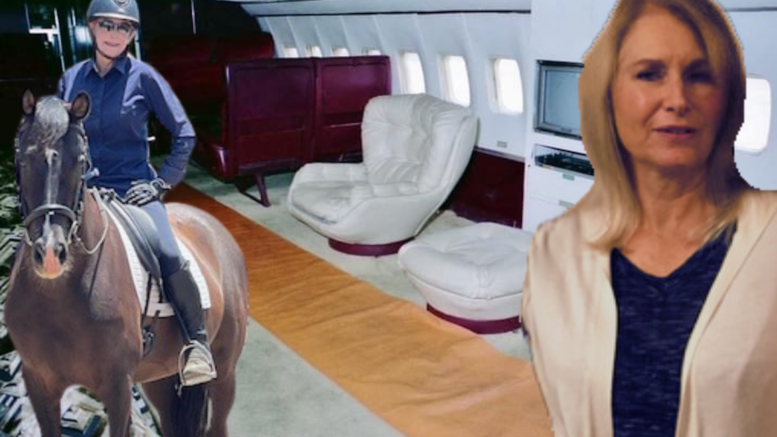
What an amazing experience she must’ve had.
Great job on this! Thanks for posting.
Love this article! Thanks!
Great read. Is the book available?